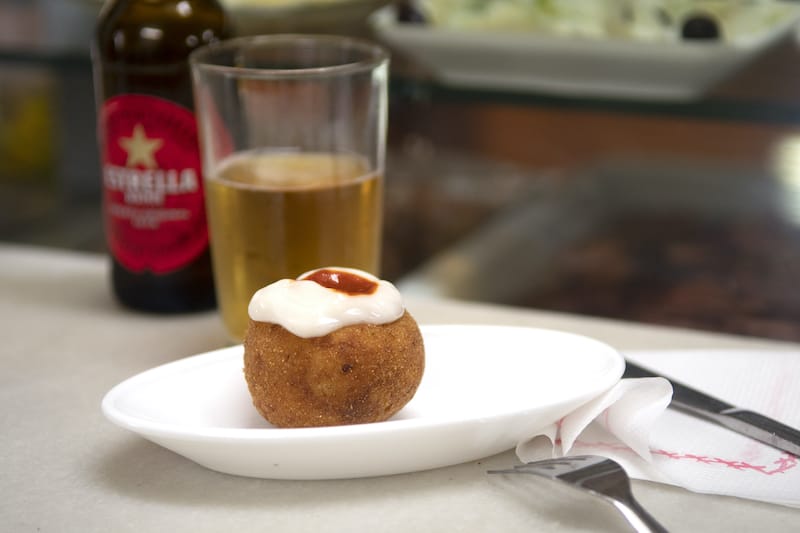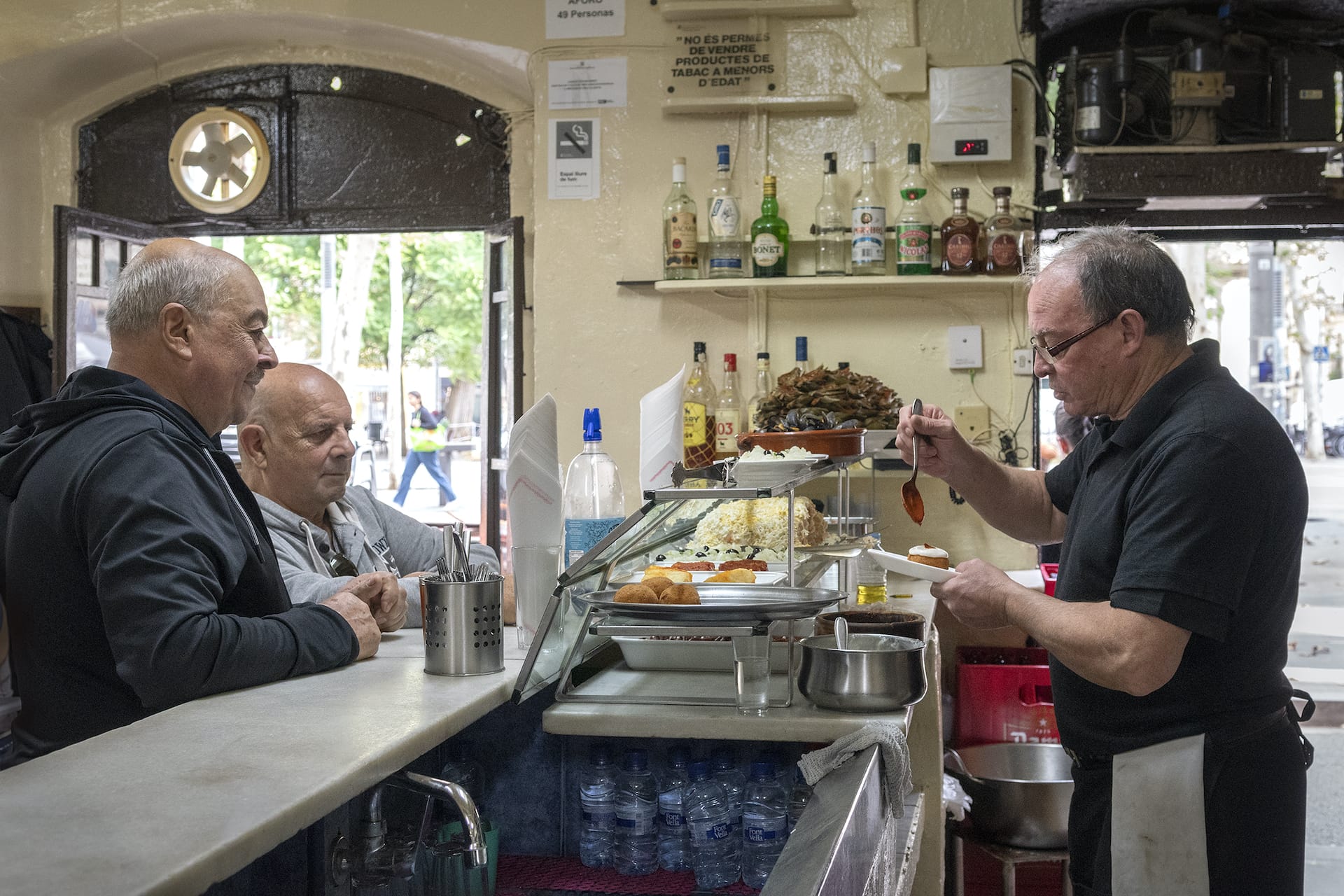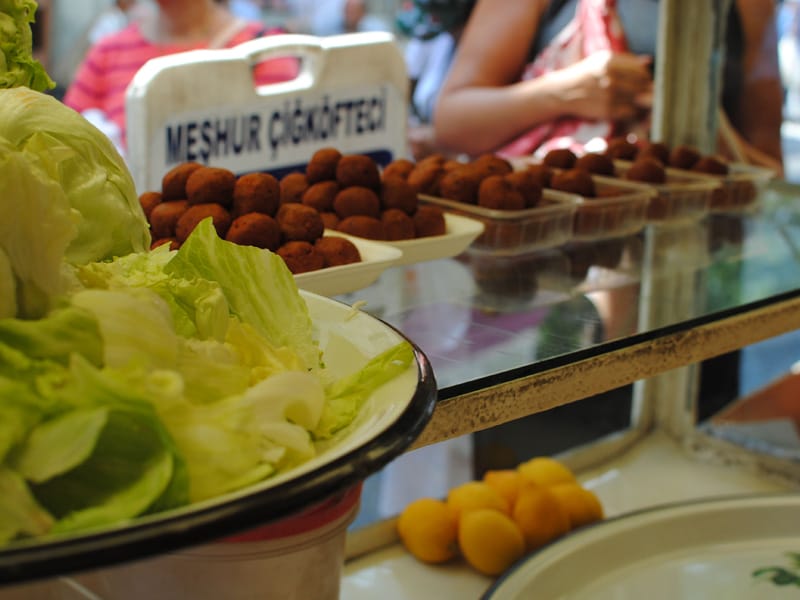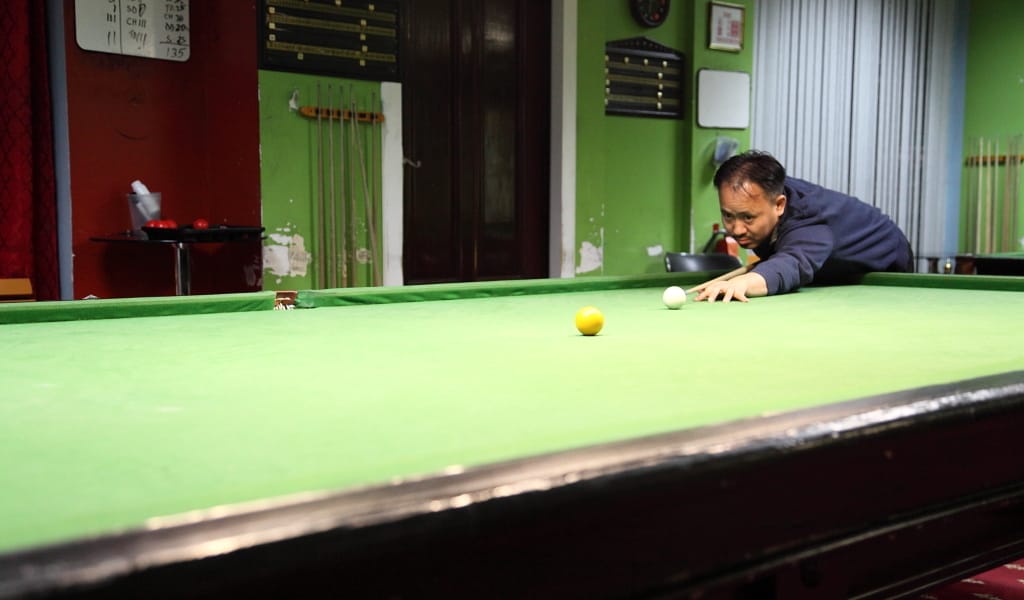Opened in 1944, La Cova Fumada (“The Smoked Cave”) is one of the most beloved gastronomic icons in Barcelona’s port area. Every day, people from all over the city come here to enjoy the powerful charms of the smell of fried fish, the spicy bite of their original “potato bombs” and the warmth of the familiar, old-school atmosphere. This is a place to take off your tie, eat with your fingers and put aside your smartphone, lest the screen get covered with grease from your fingers.
 Inside the restaurant, the atmosphere has remained almost unchanged since the 1940s. In those difficult years just after the Spanish Civil War, the main customers at this typical bodega were people from the neighborhood and workers at shipyards in the port and the famous nearby “Maquinista” ironworking and machine factory, who came to have a glass of wine and to heat up their own food in the open “cheap kitchen.” The same spirit still pervades the tiny venue today, from the seven old, marble-topped tables and the same cramped kitchen to the almost-prehistoric blackboard – with the same menu, always written in chalk – and the wooden wine barrels connected to a couple of taps set into a marble panel, on which bar tabs are recorded in pencil. Everything here looks like a blast from the past. More than just an eatery, the place is truly part of the city’s ethnographic heritage. (Although La Cova is located in the market square of La Barceloneta and has two entrances, it’s not so easy to find if you don’t know what you’re looking for. There are no signs over the doors, so you’ll have to look for the people waiting outside and follow your nose toward the aromas wafting out the window from the kitchen.)
Inside the restaurant, the atmosphere has remained almost unchanged since the 1940s. In those difficult years just after the Spanish Civil War, the main customers at this typical bodega were people from the neighborhood and workers at shipyards in the port and the famous nearby “Maquinista” ironworking and machine factory, who came to have a glass of wine and to heat up their own food in the open “cheap kitchen.” The same spirit still pervades the tiny venue today, from the seven old, marble-topped tables and the same cramped kitchen to the almost-prehistoric blackboard – with the same menu, always written in chalk – and the wooden wine barrels connected to a couple of taps set into a marble panel, on which bar tabs are recorded in pencil. Everything here looks like a blast from the past. More than just an eatery, the place is truly part of the city’s ethnographic heritage. (Although La Cova is located in the market square of La Barceloneta and has two entrances, it’s not so easy to find if you don’t know what you’re looking for. There are no signs over the doors, so you’ll have to look for the people waiting outside and follow your nose toward the aromas wafting out the window from the kitchen.)
But La Cova Fumada is also rightfully legendary for its food – in particular, for having introduced the bomba, or potato bomb, said to have been invented in the 1950s by María Pla, grandmother of the current owners, brothers Josep María y Magí Sole. Her original version of this dish – which has since become one of Spain’s most famous and classic tapas – was a small ball made of mashed potatoes with some pork inside, rolled in breadcrumbs and egg, deep-fried in olive oil and, finally, served with either aioli (mayonnaise with garlic) or a spicier sauce made with cayenne peppers.

Beyond the renowned potato bombs, the menu on the blackboard is more or less a roster of classic tapas and small portions of fresh seafood grilled with garlic and parsley. Sardines, mackerel, prawns, squid and octopus are all served with a touch of olive oil and are best eaten with some pa amb tomàquet (bread rubbed with oil and tomato). Other excellent tapas include tender and very tasty fried artichokes, cooked chickpeas, stewed beans from Cartagena, butifarra negra (black Catalan sausage) and salt cod. Another very traditional dish is the cap i pota, a spicy Catalan stew made with the gelatinous parts of a pig’s head and feet (hence the name), also known in Spain as callos. The only change in the menu in the last 70 years is the introduction of seasonal seafood, such as fresh clams, razor clams or crawfish, which are steamed and prepared with just the freshness of the sea for flavoring.

La Cova Fumada is a place with what Spaniards call “solera,” having a sort of vintage character and maturity. And nobody in the Sola Pla family has any plans to change this. “This is the charm of the place and the family atmosphere that we like to keep; it’s what people enjoy,” said Jose María. Sometimes, the original recipe – for both food and for a successful eatery – doesn’t require any update at all.
This review was originally published on June 17, 2013.
 August 6, 2012 Hacı Beşir Usta
August 6, 2012 Hacı Beşir Usta
Editor’s note: This post was written by “Meliz,” an intrepid explorer of Istanbul’s […] Posted in Istanbul January 5, 2018 Weekender Billiard
January 5, 2018 Weekender Billiard
The view from Weekender’s doorway is promising only for those comfortable with snooker: […] Posted in Queens June 12, 2019 Neighborhood Rivalries
June 12, 2019 Neighborhood Rivalries
Over the course of June, Lisbon’s neighborhoods are perfumed with the smoke of barbecued […] Posted in Lisbon
Published on August 19, 2014
Related stories
August 6, 2012
IstanbulEditor’s note: This post was written by “Meliz,” an intrepid explorer of Istanbul’s culinary backstreets and frequent Istanbul Eats guest contributor who would like to keep her anonymity. At Istanbul Eats HQ, the conversation comes up every once in a while about how çiğ köfte has emerged as a sort of fast-food franchising opportunity: young…
January 5, 2018
QueensThe view from Weekender’s doorway is promising only for those comfortable with snooker: The room is dominated by three intimidatingly broad tables devoted to that challenging cue sport. Compared with New York’s typical coin-op bar-pool tables, a snooker table’s balls are smaller, its pockets tighter and successful shots consequently rarer. They certainly were for us.…
June 12, 2019
LisbonOver the course of June, Lisbon’s neighborhoods are perfumed with the smoke of barbecued sardines. It’s one of the most prominent features of the traditional arraiais, the festivals that pop in each neighborhood at this time of year, offering grilled fish and pork, beer and sangria, and music. While all this eating, drinking and making…








































 Inside the restaurant, the atmosphere has remained almost unchanged since the 1940s. In those difficult years just after the Spanish Civil War, the main customers at this typical bodega were people from the neighborhood and workers at shipyards in the port and the famous nearby “Maquinista” ironworking and machine factory, who came to have a glass of wine and to heat up their own food in the open “cheap kitchen.” The same spirit still pervades the tiny venue today, from the seven old, marble-topped tables and the same cramped kitchen to the almost-prehistoric blackboard – with the same menu, always written in chalk – and the wooden wine barrels connected to a couple of taps set into a marble panel, on which bar tabs are recorded in pencil. Everything here looks like a blast from the past. More than just an eatery, the place is truly part of the city’s ethnographic heritage. (Although La Cova is located in the market square of La Barceloneta and has two entrances, it’s not so easy to find if you don’t know what you’re looking for. There are no signs over the doors, so you’ll have to look for the people waiting outside and follow your nose toward the aromas wafting out the window from the kitchen.)
Inside the restaurant, the atmosphere has remained almost unchanged since the 1940s. In those difficult years just after the Spanish Civil War, the main customers at this typical bodega were people from the neighborhood and workers at shipyards in the port and the famous nearby “Maquinista” ironworking and machine factory, who came to have a glass of wine and to heat up their own food in the open “cheap kitchen.” The same spirit still pervades the tiny venue today, from the seven old, marble-topped tables and the same cramped kitchen to the almost-prehistoric blackboard – with the same menu, always written in chalk – and the wooden wine barrels connected to a couple of taps set into a marble panel, on which bar tabs are recorded in pencil. Everything here looks like a blast from the past. More than just an eatery, the place is truly part of the city’s ethnographic heritage. (Although La Cova is located in the market square of La Barceloneta and has two entrances, it’s not so easy to find if you don’t know what you’re looking for. There are no signs over the doors, so you’ll have to look for the people waiting outside and follow your nose toward the aromas wafting out the window from the kitchen.)










































